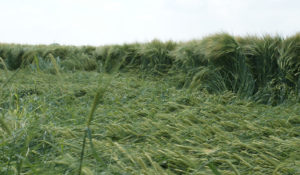Spreading
Spreading in general
The importance of proper spreading
 The consequences of spreading errors remain invisible in most cases. Deviations in the spreading pattern are only visible at a high coefficient of variation, in the form of spreading paths, which are light and dark strips in the crop. The coefficient of variation is the value of the distribution of fertiliser granules. The illustration shows spreading paths leading to major yield loss and/or quality loss. The cost of spreading errors is therefore mainly reflected in missed yields and poor crop quality.
The consequences of spreading errors remain invisible in most cases. Deviations in the spreading pattern are only visible at a high coefficient of variation, in the form of spreading paths, which are light and dark strips in the crop. The coefficient of variation is the value of the distribution of fertiliser granules. The illustration shows spreading paths leading to major yield loss and/or quality loss. The cost of spreading errors is therefore mainly reflected in missed yields and poor crop quality.
Equally influential is the cost of additional fertiliser. If there is a large overlap, too much fertiliser is consumed, which costs a lot of money. Table 1 shows the additional costs that can be incurred for different overdoses. This is based on a fertilisation rate of 200 kg N/ha at a nitrogen price of
£1.00/kg N.
| Overdose | 1 ha | 50 ha | 100 ha | 300 ha | 500 ha | 1000 ha |
|---|---|---|---|---|---|---|
| 5% | £10 | £500 | £1,000 | £3,000 | £5,000 | £10,000 |
| 10% | £20 | £1,000 | £2,000 | £6,000 | £10,000 | £20,000 |
| 15% | £30 | £1,500 | £3,000 | £9,000 | £15,000 | £30,000 |
| 20% | £40 | £2,000 | £4,000 | £12,000 | £20,000 | £40,000 |
Overdosing is usually caused by the quality of the fertiliser, the fertiliser spreader or the operator. In addition to these causes, external factors can influence the spreading deviation. These include wind, humidity and relief in a plot.
Consequences by crop
An incorrect spreading process can often be costly. If the fertiliser fails to reach the desired spot, there may be a variety of implications for crops. Below are some of the major implications for the main crops of wheat, potatoes and sugar beet.
Wheat
 When too much nitrogen fertiliser is spread in a plot of wheat, lodging can occur. Years of research have shown that lodging can cause yield losses of up to 12%. It also makes plots harder to harvest, reduces quality, increases the risk of tillering and increases moisture content when the crop is lodged. Meeting quality requirements is very important when growing baking wheat. A protein content of more than 12% is necessary. Protein content is mostly determined by nitrogen fertilisation so when too little nitrogen is spread in places, quality is seriously affected.
When too much nitrogen fertiliser is spread in a plot of wheat, lodging can occur. Years of research have shown that lodging can cause yield losses of up to 12%. It also makes plots harder to harvest, reduces quality, increases the risk of tillering and increases moisture content when the crop is lodged. Meeting quality requirements is very important when growing baking wheat. A protein content of more than 12% is necessary. Protein content is mostly determined by nitrogen fertilisation so when too little nitrogen is spread in places, quality is seriously affected.
Potatoes
Nitrogen fertilisation has a major impact on potato yield and quality. Some of the major consequences of excessive nitrogen fertilisation include
Reduction in underwater weight;
- More susceptible to Phytophthora;
- Occurrence of growth cracks;
- Grey appearance after cooking or pre-frying;
- Increased storage losses.
An inadequate nitrogen application has an adverse impact on yield in terms of tonnages.
Sugar beet
Sugar beet is prone to nitrogen deficiency. Too little nitrogen results in a lower yield per root. Excessive nitrogen has an adverse impact on sugar content and the extractability of sugar from the beet. A high sugar content is essential if a good payout price is to be obtained.


